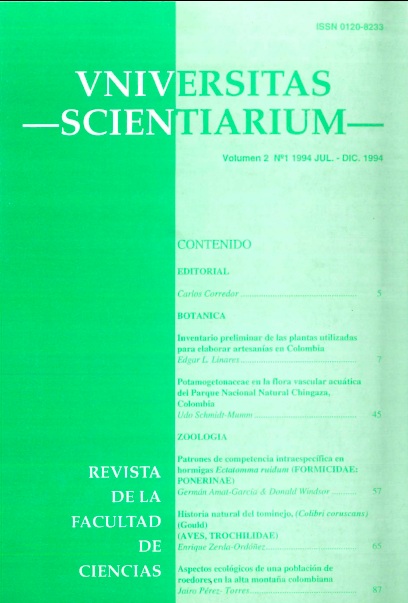Abstract
Cell cultures from bone marrow and peripheral blood obtained by cardiac puncture were used to describe the karyotype of the field m o use Tomasomys laniger laniger in two populations found in the areas of Cruz Verde andEl V erjon, Cundinamarca, (Col.). C-banding and Giemsa staining allowed us to ascertain its diploid number 2n=24 with nine pairs of metacentric, two submetacentric and one acrocentric chromosomes; the fundamental number (FN) was 46. The X chromosomes have a heterochromatic markerband in the q arm; pair 10 has conspicuous satcllites and the Y is a large and uni-que acrocentric chromosome equivalent to more than 5% of the total length of the genome. Polymorphism was observed in and between the two populations. Cytogenetic characteristics of Th. laniger lani-ger differ from other species of the genus, and show a great deal of similarities to o"ther cricetids such as Cricetulus griseus.Univ. Sci. is registered under a Creative Commons Attribution 4.0 International Public License. Thus, this work may be reproduced, distributed, and publicly shared in digital format, as long as the names of the authors and Pontificia Universidad Javeriana are acknowledged. Others are allowed to quote, adapt, transform, auto-archive, republish, and create based on this material, for any purpose (even commercial ones), provided the authorship is duly acknowledged, a link to the original work is provided, and it is specified if changes have been made. Pontificia Universidad Javeriana does not hold the rights of published works and the authors are solely responsible for the contents of their works; they keep the moral, intellectual, privacy, and publicity rights. Approving the intervention of the work (review, copy-editing, translation, layout) and the following outreach, are granted through an use license and not through an assignment of rights. This means the journal and Pontificia Universidad Javeriana cannot be held responsible for any ethical malpractice by the authors. As a consequence of the protection granted by the use license, the journal is not required to publish recantations or modify information already published, unless the errata stems from the editorial management process. Publishing contents in this journal does not generate royalties for contributors.



